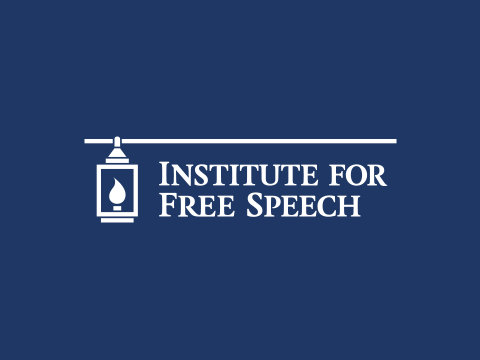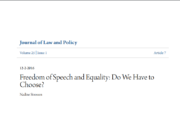The Politico political cartoon “Equal access” offers a window into the way many people assume campaign contributions and campaign finance laws generally work. The cartoon depicts several messages from citizens to the fictional Senator Schmutz, as well as a Koch Industries check made out to Senator Schmutz for $500,000 with “that vote…” written in the memo line.
Let us count the ways in which what’s depicted in the cartoon is already illegal:
- The check is made out to Senator Schmutz, not his campaign committee, so this isn’t even a campaign finance issue, it’s straightforward bribery.
- It would still be illegal if the check had been made out to Senator Schmutz’s campaign committee, because Koch Industries is a corporation, and corporations are prohibited from contributing to the campaigns of federal candidates.
- It would still be illegal if the check had been written by an individual – say, David Koch – and had been made out to Senator Schmutz’s campaign committee, because $500,000 far exceeds the current contribution limits. Each Koch brother (and every American) can give only a maximum of $5,200 to a candidate’s campaign committee per election cycle.
Moreover, the explicit exchange of an official favor for money is precisely the kind of corruption that the Supreme Court has said the government may prevent. The cartoonist no doubt believes he is lampooning the current state of campaign finance law, but he actually comes closer to endorsing it. As Chief Justice John Roberts wrote in April 2014’s McCutcheon v. FEC decision (internal quotes omitted):
“In a series of cases over the past 40 years, we have spelled out how to draw the constitutional line between the permissible goal of avoiding corruption in the political process and the impermissible desire simply to limit political speech. We have said that government regulation may not target the general gratitude a candidate may feel toward those who support him or his allies, or the political access such support may afford. Ingratiation and access…are not corruption. They embody a central feature of democracy—that constituents support candidates who share their beliefs and interests, and candidates who are elected can be expected to be responsive to those concerns.
Any regulation must instead target what we have called quid pro quo corruption or its appearance. That Latin phrase captures the notion of a direct exchange of an official act for money. The hallmark of corruption is the financial quid pro quo: dollars for political favors. Campaign finance restrictions that pursue other objectives, we have explained, impermissibly inject the Government into the debate over who should govern. And those who govern should be the last people to help decide who should govern.” (Emphasis added.)
This is precisely what is depicted in the cartoon: a direct exchange of an official act for money. The cartoon is titled “Equal access,” but the exchange it depicts between a contributor and a public official is not an example of mere ‘access’; rather, it is a quintessential example of quid pro quo corruption, and is against the law. In fact, the Supreme Court not only allows the government to prohibit such exchanges, it also allows government to take additional indirect measures to prevent such exchanges from taking place.
Those measures include limiting and disclosing the sources and amounts of all campaign contributions over de minimis amounts as well as various other forms of political spending on speech and association. As CCP Chairman and former FEC Commissioner Bradley A. Smith recently explained, our campaign finance regulatory regime features “federal laws and federal regulations total[ing] over 376,000 words. That’s about 75% longer than Plato’s Republic. On top of that we can add 1900 advisory opinions and thousands of pages of state laws and thousands of federal pages trying to explain the 376,000 words that are actually in the regulations.” This sprawling, complex body of law is almost entirely founded on the government’s power to regulate campaign finance to prevent the cartoon’s scenario from taking place.
As a result, this serves as a teachable moment for the Court’s critics: SCOTUS may not have made the arguments you think they made. If your conception of corruption is trading money for votes, SCOTUS and defenders of free speech agree. It is inaccurate to characterize the debate over what measures government may take in pursuit of its goal of “preventing corruption,” and what burdens it may place on our fundamental rights of speech and association, as a debate over whether government may do anything at all to prevent or reduce the exchange of money for votes.
Lastly, I can’t help but point out that the cartoon not only gets the law wrong, but implies a relationship between money and votes that does not exist. Imagine a world with no laws against bribery or quid pro quo corruption. To take two prominent examples, does anyone honestly believe Senator Harry Reid would stop publicly criticizing the Koch brothers and Koch Industries if they paid him? Or that Senator Mitch McConnell would support strong climate change legislation if Tom Steyer wrote him a check?
The answer, I think, is no. There’s a reason donors give to candidates that already agree with them: you can’t change most legislators’ minds with money. If you could, donors would be contributing in droves to candidates that disagree with them in order to change those candidates’ positions. Instead, what we see in the real world is contributors giving to candidates that already share their views. That in itself is strong evidence that votes on legislation cannot be easily “bought” in the manner implied by the cartoon, and academic research largely agrees: scholarly studies have found that “campaign contributions had no statistically significant effects on legislation.”
Of course, political cartoons can always plead they are just trying to be funny and shouldn’t be analyzed so seriously. But when you strip the hyperbole from “Equal access,” what’s left is nothing more than old discredited myths about money in politics. Clarifying the picture reveals that there isn’t actually that much space between the views of the Supreme Court and everyday citizens who are concerned about money in politics – many of whom are misled about our current campaign finance laws by depictions like this. If only we could calm the rhetoric, we might find common ground.














